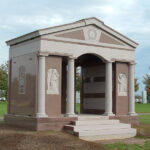Army of Tennessee Tumulus and Pierre Gustave Toutant Beauregard
Tumulus
Riding astride his noble steed, Fire Eater, General Albert Sidney Johnston, Confederate States of America, directs his troops to charge the Federal lines on the first day of the Battle of Shiloh. Seconds later he was felled by a Yankee bullet, ending his short, but illustrious, career. Now, he is frozen for all time directing automobiles, trucks and motorhomes speeding toward downtown New Orleans on Interstate 10. The General and his steed crown the Benevolent Association, Army of Tennessee, Louisiana Division tumulus in Metairie Cemetery.
The tumulus is one of mankind’s oldest burial monuments, dating back to 4 to 5,000 BC. Examples of tumuli can be seen peppering the landscape all over Western Europe. The foundations of most ancient tumulus style monuments are assemblages of large rocks, known as megaliths. These rock megaliths are not unlike Stonehenge, but are smaller in scale. A megalith is transformed into a tumulus with the addition of rubble or earth to form a large, imposing mound. Many megaliths seen today were, at one time, tumuli. Time and erosion have worn away their earth and rubble covering to reveal their megalithic foundation. Many large cemeteries have a tumulus or two. When found in modern American cemeteries, they are often used for members of fraternal societies or military organizations such as the Army of Tennessee, because of their association with warriors.
The Army of Tennessee tumulus is one of four monuments in Metairie Cemetery dedicated to men who fought in the Civil War. This is particularly interesting since Metairie Cemetery was founded seven years after the close of the Civil War. The statue of General Johnston was not unveiled until 1887, over twenty years after the war. But, in the South and in New Orleans, the memory of the Civil War was still very much alive even two decades later.
Because of its vertical prominence and its location near the pedestrian entrance to the cemetery, the Army of Tennessee Tumulus is one of the most recognized monuments in the cemetery. Its distinctive form has been preserved in books, magazines and postcards. The monument was designed by famed New Orleans tomb contractor Pierre Casse. The project engineer was one John Glenn. The bronze statue of General Johnston at the top of the tumulus and a marble statue at the base of the tumulus depicting a Confederate soldier reading the roll of the honored dead were crafted by a Northerner, sculptor Alexander Doyle of New York. When the statue at the base of the tumulus was constructed the soldier had a carbine resting in the crook of his arm, but the rifle was stolen, no doubt by a souvenir hunter. At a later date a second marble rifle was commissioned from a firm in Italy and it was doweled in place. Once again it was pried from the statue, but the thief dropped the stone carbine while he was jumping over the fence to make his escape and it broke into many pieces. Rather than piece the gun back together or order another replica, it was decided to leave the soldier unarmed.
The tumulus is entered through a Gothic archway designed by a New Orleans sculptor, Achille Perelli. There are 48 crypts containing the remains of members of the Army, three of which are sealed for all time. The sealed crypts contain the remains of Colonel Charles Didier Dreux, the first Confederate field officer to be killed in battle; General Pierre Gustave Toutant Beauregard, who ordered the first shot fired at Fort Sumter and John Dimitry, the man who wrote General Johnston’s epitaph. The epitaph is on a large plaque at the back of the tumulus. It reads:
Albert Sidney Johnston
A General in the Army of the Confederate States,
Who fell at Shiloh, Tennessee, on the sixth day of April,
Eighteen Hundred and Sixty-two
A man tried in many high offices and critical enterprises
and found faithful in all.
His life was one long sacrifice of interest to conscience
And even that life, on a woful Sabbath,
Did he yield as a Holocaust at his country’s need.
Not wholly understood was he while he lived;
But in his death, his greatness stands confessed
In a People’s tears.
Resolute, moderate, clear of envy, yet not wanting
In that finer ambition that makes men great and pure,
In his honor—impregnable;
In his simplicity—sublime
No country e’er had a truer son, No cause a nobler champion,
No people a bolder defender, No principal a purer victim
Than the dead soldier!
His fame consigned to the keeping of that time which,
Happily Is not so much the tomb of Virtue as its Shrine,
Shall in the years to come fire Modest Worth to Noble Ends.
In honor now our great Captain rests;
A bereaved people mourn him;
Three commonwealths proudly claim him;
And history shall cherish him;
Among those choice spirits, who holding their conscience unmixed with blame,
Have been in all Conjunctures true to themselves, their People and their God.
Curiously, despite the imposing statue of Johnston topping the tumulus and the flowery epitaph, he is not actually buried in the tumulus. Johnston’s body was secretly moved to the Texas State cemetery in Austin. The most famous person buried in the tumulus is General Beauregard (see below). There were many more members of the Benevolent Association who wanted to be buried in the tomb than there were crypts to house their remains. When space was needed for another burial one of the crypts was opened, then the remains of the previous occupant were placed on lead sheets, which were soldered together. The package was tagged and placed in a large ossuary in the back of the tumulus. Consequently most of the crypts have a number of names engraved on them. Burials continued in the Army of Tennessee Tumulus until December 30th, 1929 when the body of Captain George A. Williams Assistant Adjutant General, Confederate States of America was interred. There are no more members of the Army of Tennessee. No more of the soldier’s bones will be wrapped in lead sheets and stacked up like cordwood. The soldiers of the Army of Tennessee can rest easy.
Pierre Gustave Toutant Beauregard
May 28, 1818-Feb. 20, 1893
Pierre Gustave Toutant Beauregard, usually known as P. G. T. Beauregard or G. T. Beauregard was the first prominent southern general of the Civil War. Beauregard was born to a white Creole family on a plantation outside New Orleans. He spent his early life at New Orleans schools and a French school in New York, before attending then graduating in 1838 from the United States Military Academy at West Point. While at West Point he acquired the nickname “The Little Creole”. After graduation he served as an engineer in the Mexican-American War under general Winfield Scott. Returning to Louisiana, in 1841, he married Marie Laure Villeré, the daughter of sugar planter Jules Villeré, Marie died in 1850 after the couple had three children.
Beauregard returned to West Point to teach in January 1861 but resigned after only five days when Louisiana seceded from the Union. Beauregard entered the Confederate army and by July 21st 1861 had been promoted to full general. He advised Confederate President Jefferson Davis to station substantial forces to protect New Orleans; a request that Davis denied. New Orleans fell on May 1, 1862 without a single casualty. The Battle of New Orleans became a major turning point of the Civil War and created a lifelong friction between Beauregard and Davis.
Beauregard had already made a name for himself by ordering the shelling of Fort Sumter, which was the official beginning of the Civil War. He went on to defeat the Union troops at the First Battle of Bull Run (First Manassas) on July 21, 1861. During the Civil War Beauregard participated in many battles and achieved a number of victories despite often being undermanned. He is also known as the man who standardized the Confederate Battle Flag and made it the most popular symbol of the Confederacy. The original Stars and Bars flag was often difficult to distinguish from the Union flag on the battlefield, making battlefield maneuvers, at times, problematic.
After the war Beauregard spoke in favor of civil rights for the recently freed slaves, a very unpopular stance at that time. He went into government service and authored a number of books and articles often blaming Davis for losing the Civil War (Davis often blamed Beauregard for losing the war). When Davis died in 1889, Beauregard was invited to ride in one of the lead carriages in the funeral procession. Beauregard declined, stating that Davis’ death “did not overly disturb him”.
Pierre Gustave Toutant Beauregard died in New Orleans four years later and was buried in the Army of Tennessee tomb in Metairie Cemetery. The tomb has multiple crypts that were often opened and reopened to receive the remains of Confederate soldiers. Beauregard’s crypt is one of only three that are sealed for all time.
Photos and text © Douglas Keister Visit Doug’s Author Page

